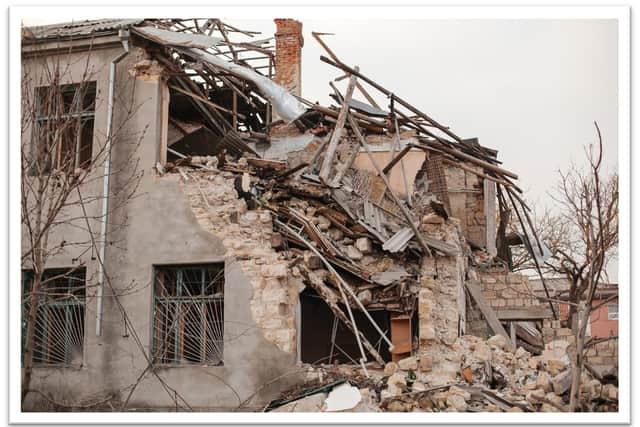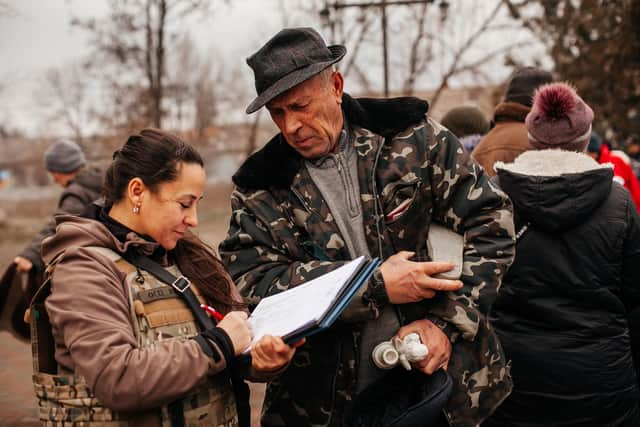Scottish charity working to deliver seeds and gardening equipment to allow devastated Ukrainian villages to become self-sufficient
“The news on Ukraine has always been so bleak, it's a bit like Narnia, where it's always winter and never Christmas,” says Mr Lynas, senior programme adviser at Scottish charity Blythswood Care, referencing classic novel The Lion, The Witch and The Wardrobe. “I think spring is just a real opportunity of growth, regeneration, rebirth, all those kinds of opportunities of starting afresh.”
Highlands-based Blythswood Care, working in partnership with local organisation Heritage Ukraine, is to distribute seeds and gardening equipment to villages in Kherson and Mykolaeiv Oblasts, some of which were previously occupied by Russian troops - to allow them to become self sufficient as food supplies continue to be disrupted.
Advertisement
Hide AdAdvertisement
Hide AdThe £250,000 Scottish Government funding for the project, distributed by development charity Christian Aid, will also allow the organisations to work on wells to provide water for around 800 households and repair damage to properties for people who have stayed throughout the war, as well as those who are returning home for the first time in months.


“It meets the needs that are often forgotten about, which are increasing as returnees are moving,” says Mr Lynas. “A lot of the research is showing that the IDP (people displaced within Ukraine) numbers are decreasing slightly, while the returnee figures are increasing.
“This suggestion came up that we look at how we can support those people who perhaps don't have access to adequate nutritional support.”
The charities hope the fruit and vegetables planted in villages will provide much-needed fresh produce for people who have survived a long and difficult winter of food shortages and power cuts - as well as shelling and other atrocities associated with the war. Some households with small holdings attached to their homes, will also be given chickens and ducks as well as a small number of goats and sheep.
Tools to farm the land, including spades, buckets and rakes, will also be handed out as those previously owned by the villagers have been taken by occupying troops.


While some locals who fled abroad or to other parts of the country are beginning to venture back to their properties following Russian occupation, others, particularly elderly and vulnerable people, have stayed throughout the conflict, with scant access to reliable food supplies.
“There's a real opportunity to take advantage of the resources that are there,” says Mr Lynas. “When a lot of the aid agencies come over, they're bringing pulses, but to try to build up your health and immunity in what is coming out of a very difficult winter, it’s really important that there is variety in there.
"Also just to give people their own feeling of worth, to actually have seeds to grow, to actually have chickens to look after. It gives that kind of sense of purpose, so there's a lot of positive outcomes that could come from this.”
Advertisement
Hide AdAdvertisement
Hide AdMs Harrison, head of the Ukraine programme at Christian Aid, says villagers will be given the opportunity to grow tomatoes, cucumbers, radishes, onions, potatoes and root vegetables, as well as strawberries and blackberries – with the aim of growing edible food within a couple of months.
"Ideally, it will be the kind of fruit and veg that will improve nutritional value, but also which is ideal for planting right now and be ready in two or three months,” she says. “We're not thinking of crops that will take a long time to develop. This is for food security as soon as possible.”
Mr Lynas points to the high quality soil in the east of Ukraine.
“There’s the potential of making a difference very quickly and trying to get nutrients introduced into the diet,” he says. “We look a a lot of the pale kids who haven’t been out – first because of Covid for two years and then because of the war.”
Other food supplies are patchy, due to a combination of supply issues as well as soaring prices in shops.
“One of the main issues is mines in different areas and the difficulties in transport to get to places and to deliver,” he says. “A lot of the aid agencies were facing the problems when places were de-occupied of actually getting stuff in where needed. That was a big issue that they were facing.
"Prices have shot up – it’s supply and demand and the villagers wages are are not all that high to begin with. There is some means of getting food, but it's limited and the prices are high.”
Many properties in villages are derelict, either from severe damage from Russian shells, or after being left empty by families who have fled the conflict areas. The 15 wells which will be brought on line as part of the scheme will be a mixture of those already in existence but which have been damaged by war and others which were have not been in use for years due to villagers installing indoor plumbing, but which can be easily adapted for modern use.
Advertisement
Hide AdAdvertisement
Hide Ad“There are a lot of shells,” says Mr Lynas. “People in a lot of cases don’t know what they’re coming back to."
“Many villages [in the programme] are those that have been under occupation, some are very close to the frontline; many have been severely impacted by shelling, airstrikes and are very close to the conflict there,” adds Ms Harrison.
“Many of those who did remain in the area, under occupied rule, were particularly vulnerable people: perhaps elderly people or those with a disability. For some people it was a choice and they wanted to stay in their home, as part of the Ukrainian resistance, continuing life – but actually for others, it wasn’t a choice, they just didn’t have the same mobility to move, to evacuate, to flee as others did.”
The funding is part of the £1 million pledged for Ukraine by the government last month, when the British Red Cross also received £375,000 and Scottish Catholic International Aid Fund (SCIAF) £375,000 for separate humanitarian projects in the country.
International development minister Neil Gray said: “[The funding] will ensure that the most vulnerable people across Ukraine are living in warm and safe accommodation and that essential facilities will be able to continue working to protect the people they serve. it will also enable families to begin to restore their homes and livelihoods following a challenging winter – helping them to repair damage and improve the food and water supply.”
Comments
Want to join the conversation? Please or to comment on this article.
